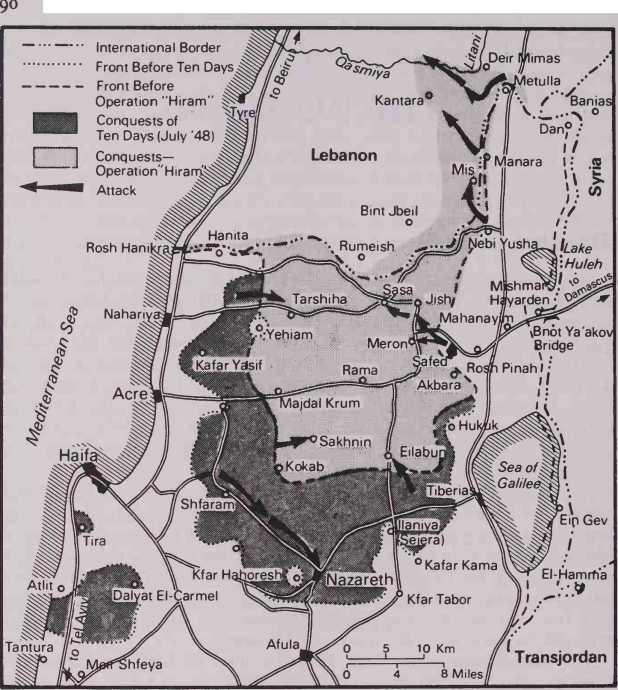In the northern sector of the War, the area under the control of Kaukji’s Arab Liberation Army was a major enclave, resting in the north on the Lebanese border; in the east, southwards from near Metulla to a point but a few miles to the west of the Sea of Galilee; thence westwards, via Eilabun turning northwards, back to the Lebanese border, past Majdal Krum and Tarshiha. His forces were now reduced to 3,000-4,000 men divided into three brigades: the 1st ‘Yarmuk’ Brigade, supported by Lebanese volunteers, was operating in the hills south of the Acre-Safed road; the 2nd ‘Yarmuk’ Brigade was deployed facing Safed between Meron and Sasa; and the 3rd ‘Yarmuk’ Brigade held the western side of the pocket, based on Tarshiha. Between them, these forces disposed of a limited number of 75mm field guns and some armoured cars. On 22 October, Kaukji launched a surprise attack with his reorganized forces in the area of Manara, in the hills to the west overlooking the ‘finger’ of Galilee. The strongpoint of Sheikh Abed was taken, the village of Manara isolated, and an Israeli counterattack repulsed. The Lebanese Army, meanwhile, still had four battalions along the border, and the three Syrian brigades manned the eastern border south to El-Hamma.
The Israelis now determined to clear Galilee of Arab forces, destroy Kaukji’s ALA and establish an Israeli defensive line along the international Palestinian-Lebanese border. The forces available to General Carmel, commanding the northern front, were now four brigades: the 7th Brigade, the ‘Oded’ Brigade (which had been brought back north from the Negev), and the ‘Golani’ and ‘Carmeli’ Brigades. There were now four artillery batteries, two with 75mm guns and two with 65mm guns. The Israeli offensive was codenamed Operation ‘Hiram’ after the King of Tyre (an ally and friend of King David and King Solomon, who had sent cedars to build the Temple in Jerusalem). It was mounted on the night of 28/29 October, and took the form of a pincer movement, the arms of which would meet at Sasa near the Lebanese border and close off the Arab pocket in Galilee. The 7th Brigade would move from Safed to Sasa, while the ‘Oded’ Brigade from the west would take Tarshiha and then close in on Sasa. At the same time, diversionary attacks were to be mounted by the ‘Golani’ units from the south in the direction of Eilabun. To the northeast, the ‘Carmeli’ Brigade would occupy the attention of the Syrians.
The 7th Brigade, under the command of Colonel Ben Dunkelman, consisted of an armoured battalion and two infantry battalions, including

Operation 'Hiram/29-31 October 1948
A company of Circassians.5 Moving from Safed on the evening of 28 October, it was engaged in a bitter infantry action at Meron as a result of which the Arabs withdrew, leaving 80 dead on the battlefield. The Brigade advanced and captured Jish (the site of Gush Halav, one of the fortresses that had held out against the Romans during the Jewish rebellion in the second century ad). A Syrian battalion, which had been hurriedly moved down from Lebanon to reinforce the Arab defences, was ambushed by Israeli units before it could deploy for attack, and withdrew in disorder leaving over 200 dead on the battlefield. The 7th Brigade pushed on to Sasa, and completed its mission as the eastern arm of the pincer movement. The western operation of the pincer movement, mounted by
The ‘Oded’ Brigade, was less successful: it failed to capture Tarshiha, and a Druze company attached to it found itself in serious trouble. However, the news that the 7th Brigade had taken Sasa in their rear unsettled the Arab defenders of Tarshiha, and they withdrew towards Lebanon, abandoning all their heavy equipment. The next day, 30 October, the ‘Oded’ Brigade mounted a new attack and Tarshiha surrendered, enabling the western arm of the pincer movement to close on Sasa.
The second phase of Operation ‘Hiram’ was now implemented. ‘Golani’ forces advanced northwards from Eilabun and, by the evening of the 21st, reached the Tarshiha-Sasa road. The Arab Liberation Army had, in fact, ceased to exist. Carmel ordered his forces to follow-up at once: the ‘Oded’ Brigade was ordered to mop-up and clear the area between Nahariya and Sasa, south of the Lebanese border, while the 7th Brigade moved rapidly from Sasa north-eastwards towards Malkiya, which had been the scene of very heavy fighting early in the war. The defending Arab forces broke and fled. The IDF now controlled the entire Lebanese border from Nebi Yusha in the east, to Rosh Hanikra on the Mediterranean coast. The siege of Manara was lifted, and units of ‘Carmeli’ Brigade crossed the border into Lebanon, capturing fourteen Lebanese villages and reaching the River Litani. (This area was later to be used as a bargaining factor in the armistice negotiations before it was eventually returned to the control of the Lebanese.)
At dawn on 31 October, Operation ‘Hiram’, the last operation to be undertaken in the north during the war, came to a close. Kaukji’s ALA had been totally defeated and eliminated, its remnants having been taken prisoner or driven out of Galilee. Arab casualties in the operation had included some 400 killed and 550 prisoners. The Lebanese Army had, in fact, withdrawn from the war, and Israel held a strip of territory in the Lebanon from the Litani south to Malkiya. The Syrians retained their bridgehead at Mishmar Hayarden, but apart from this the entire area of the Galilee was in Israel’s hands. For all practical purposes, the war along Israel’s northern borders had come to an end.




 World History
World History









